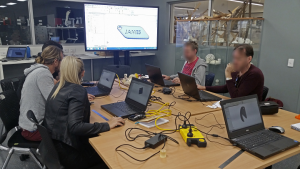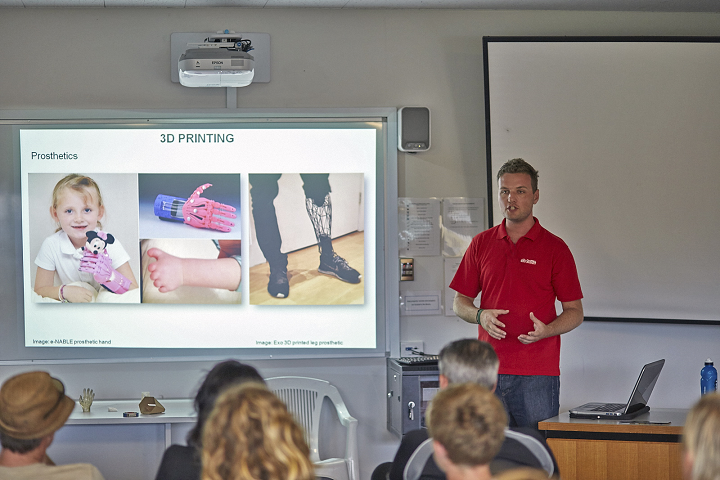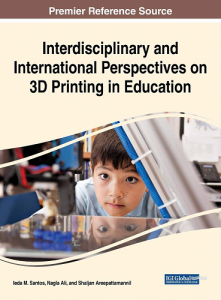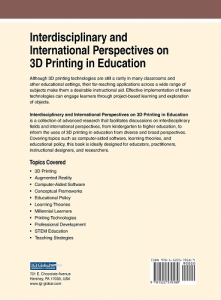Dr. James Novak, a postdoctoral researcher, industrial designer, and self-professed 3D printing geek, started a blog called edditive back in 2014 as a way to document his 3D printing projects. He recently got in touch with 3DPrint.com to let us know about his latest project – he wrote a chapter in a newly released book about 3D printing, titled “Interdisciplinary and International Perspectives on 3D Printing in Education.”
“Obviously 3D printing is changing education in many ways, but it is also challenging for teachers and schools to understand and bring into the classroom,” Dr. Novak told us. “This book can help fill this gap in knowledge.”
The book, which is nearly 350 pages long, covers a wide variety of academic topics, including:
- 3D printing
- STEM Education
- Professional Development
- Millennial Learners
- Conceptual Frameworks
- CAD Software
- Augmented Reality
The book is a collection of research which can be used to assist during discussions related to interdisciplinary fields and educational perspectives from all around the world, all the way from kindergarten up through institutions of higher learning, to, as the description reads, “inform the uses of 3D printing in education from diverse and broad perspectives.”
“Although 3D printing technologies are still a rarity in many classrooms and other educational settings, their far-reaching applications across a wide range of subjects make them a desirable instructional aid,” the book’s description reads. “Effective implementation of these technologies can engage learners through project-based learning and exploration of objects.”
 The book was designed and written specifically for educators, instructional designers, practitioners, and researchers. Dr. Novak’s 22-page chapter is titled “Re-Educating the Educators: Collaborative 3D Printing Education,” and, as he told us, “covers research into how to upskill school teachers in 3D printing through collaboration with universities.”
The book was designed and written specifically for educators, instructional designers, practitioners, and researchers. Dr. Novak’s 22-page chapter is titled “Re-Educating the Educators: Collaborative 3D Printing Education,” and, as he told us, “covers research into how to upskill school teachers in 3D printing through collaboration with universities.”
“I have been running workshops for teachers for 5 years based at universities in Australia and in the chapter I detail the contents of a one day workshop for school teachers, broken up into 3 sessions, and all involving hands-on activities,” Dr. Novak explained to 3DPrint.com. “This could be adopted by any other trainers of teachers, and the book as a whole will interest a broad range of 3D printing researchers and practitioners, as well as curriculum planners and educators of all levels.
“The majority of 3D printing news articles focus on new technological achievements in the industry, and this could be a good opportunity to provide some new resources to the educators involved in training the next generation of designers, engineers etc.”
Dr. Novak’s book chapter uses images from some of his one-day workshops, which he also discusses in the book, and the goal behind the chapter is to call attention to some of the many real challenges that plague teachers who are attempting to adopt 3D printing in the classroom. The chapter starts with a summary of how Australian schools are adopting the technology, and moves on to new research and peer-reviewed literature about how short, intensive courses are helpful in offering teachers “meaningful training” in regards to 3D printing.
“Despite increasing pressure from Science, Technology, Engineering and Mathematics (STEM) policies, there is little support offered to schools and teachers to learn 3D printing and associated skills such as Computer-Aided Design (CAD) and 3D scanning,” the chapter introduction reads. “Such technologies have traditionally been the domain of designers and engineers, trained through years of university and commercial practice, and may be daunting for many teachers, particularly those in disciplines where computing and technical expertise is minimal. It is unrealistic to expect teachers to add lengthy training courses in these technologies to their already busy workload, so novel methods of training, driven by bottom-up engagement, must be implemented to ensure teachers and students benefit from the opportunities presented by 3D printing.”
Other interesting chapters in the book include “3D Printing Glitches: Learning From Manufactured Errors,” “Girls and 3D Printing: Considering the Content, Context, and Child,” and “Creating Tactile Graphs for Students with Visual Impairments: 3D Printing as Assistive Technology.”
While this is all well and good, when I saw the price of this book I nearly had a heart attack – the list price for a hardback copy is $195, and while the price drops 20% to $156 when you purchase it through the IGI Global Online Bookstore, that’s still a pretty penny…and even more than it costs to purchase your own entry-level 3D printer! So you’ll need to decide if the knowledge in this book is worth breaking the bank for…or you could just purchase Dr. Novak’s chapter in PDF format for less than $40.
What do you think? Discuss this book and other 3D printing topics at 3DPrintBoard.com or share your thoughts in the Facebook comments below.
[Images provided by Dr. James Novak]Subscribe to Our Email Newsletter
Stay up-to-date on all the latest news from the 3D printing industry and receive information and offers from third party vendors.
Print Services
Upload your 3D Models and get them printed quickly and efficiently.
You May Also Like
3D Printing News Briefs, July 2, 2025: Copper Alloys, Defense Manufacturing, & More
We’re starting off with metals in today’s 3D Printing News Briefs, as Farsoon has unveiled a large-scale AM solution for copper alloys, and Meltio used its wire-laser metal solution to...
Etsy Design Rule Change Reduces Selection of 3D Printed Goods
Online marketplace Etsy has implemented a rule change requiring all 3D printed goods on the site to be original designs. The update to the site’s Creativity Standards states, ¨Items produced using...
Siraya Tech Introduces New Elastomer 3D Printing Materials, Including Foaming TPU
California company Siraya Tech, founded in 2019 with a focus on material science, customer focus, and agility, develops high-quality 3D printing materials that meet the needs of creators, hobbyists, and...
3D Printing News Briefs, April 12, 2025: RAPID Roundup
The news from last week’s RAPID+TCT in Detroit just keeps on coming! That’s why today’s 3D Printing News Briefs is another RAPID Roundup of more exciting announcements from the trade...





































